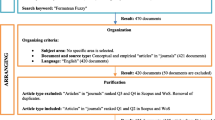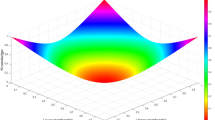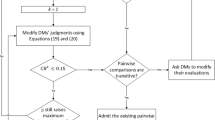Abstract
Active and healthy living is critical in an aging society. Mobile and smart technology applications can assist in achieving this goal of healthy living. However, selecting a suitable and smart technology application for active and healthy living is difficult. To address this difficulty, a fuzzy collaborative intelligence (FCI) approach was proposed in this study to assess the suitability of a mobile and smart technology application. The FCI approach is a posterior-aggregation fuzzy analytic hierarchy process approach that combines the fuzzy inverse of column sum, partial-consensus fuzzy intersection, and fuzzy technique for order preference by similarity to the ideal solution. The FCI approach starts from the prioritization of critical factors using the fuzzy inverse of column sum by each expert. Subsequently, partial-consensus fuzzy intersection is applied to aggregate the priorities derived by all experts. Based on the aggregation result, each mobile and smart technology application for active and healthy aging is assessed using fuzzy technique for order preference by similarity to the ideal solution. The FCI approach was applied to assess five existing mobile and smart technology applications, with various aspects of life as parameters. According to experimental results, the most and least suitable mobile technology applications were smart canes and online food ordering and delivery platforms, respectively. This is because the current elderly population is not very familiar with smartphone applications. This problem will be solved over time when the current middle-age population becomes old. In addition, the ranking result obtained using the proposed methodology was considerably different from those using several existing methods. The aging of population is a natural phenomenon. The results of this study are helpful to creating an environment that is friendly and assists elderly people to age actively and healthily.








Similar content being viewed by others
References
Ahmed F, Kilic K. Fuzzy analytic hierarchy process: a performance analysis of various algorithms. Fuzzy Sets Syst. 2019;362:110–28.
Beard JR, Officer A, De Carvalho IA, Sadana R, Pot AM, Michel JP, Lloyd-Sherlock P, Epping-Jordan JE, Peeters GMEE, Mahanani WR, Thiyagarajan JA, Thiyagarajan JA. The World report on ageing and health: a policy framework for healthy ageing. The Lancet. 2016;387(10033):2145–54.
Callari TC, Moody L, Magee P, Yang D. ‘Smart–not only intelligent!’ Co-creating priorities and design direction for ‘smart’ footwear to support independent ageing. Int J Fash Des Technol Educ. 2019;1–12.
Castillo JC, Castro-González Á, Fernández-Caballero A, Latorre JM, Pastor JM, Fernández-Sotos A, Salichs MA. Software architecture for smart emotion recognition and regulation of the ageing adult. Cognit Comput. 2016;8(2):357–67.
Chang PT, Hung KC. Applying the fuzzy-weighted-average approach to evaluate network security systems. Comput Math Appl. 2005;49(11–12):1797–814.
Charou E, Kabassi K, Martinis A, Stefouli M. Integrating multimedia GIS technologies in a recommendation system for geotourism. Multimedia Services in Intelligent Environments, 2010;63–74.
Chen T. A hybrid fuzzy and neural approach with virtual experts and partial consensus for DRAM price forecasting. Int J Innov Comput Inf Control. 2012;8(1):583–97.
Chen T. Ubiquitous multicriteria clinic recommendation system. J Med Syst. 2016;40(5):113.
Chen T. Estimating unit cost using agent-based fuzzy collaborative intelligence approach with entropy-consensus. Appl Soft Computing. 2018;73:884–97.
Chen TCT. Evaluating the sustainability of a smart technology application to mobile health care: the FGM–ACO–FWA approach. Complex & Intelligent Systems. 2019;1–13.
Chen T, Chiu MC. Smart technologies for assisting the life quality of persons in a mobile environment: a review. J Ambient Intell Humaniz Comput. 2018;9(2):319–27.
Chen T, Lin YC, Chiu MC. Approximating alpha-cut operations approach for effective and efficient fuzzy analytic hierarchy process analysis. Appl Soft Computing 2019;105855.
Chen TCT, Wang YC, Lin YC, Wu HC, Lin HF. A fuzzy collaborative approach for evaluating the suitability of a smart health practice. Mathematics. 2019;7(12):1180.
Chiu MC, Chen TCT. Assessing sustainable effectiveness of the adjustment mechanism of a ubiquitous clinic recommendation system. Health Care Management Science. 2019;1-10.
Demiris G, Hensel BK, Skubic M, Rantz M. Senior residents’ perceived need of and preferences for “smart home” sensor technologies. Int J Technol Assess Health Care. 2008;24(1):120–4.
Do HM, Pham M, Sheng W, Yang D, Liu M. RiSH: a robot-integrated smart home for elderly care. Robotics and Autonomous Systems. 2018;101:74–92.
Giachetti RE, Young RE. A parametric representation of fuzzy numbers and their arithmetic operators. Fuzzy Sets Syst. 1997;91(2):185–202.
He Z, Han G, Cheng TCE, Fan B, Dong J. Evolutionary food quality and location strategies for restaurants in competitive online-to-offline food ordering and delivery markets: an agent-based approach. Int J Prod Econ. 2019;215:61–72.
Helbostad J, Vereijken B, Becker C, Todd C, Taraldsen K, Pijnappels M, Aminian K, Mellone S. Mobile health applications to promote active and healthy ageing. Sensors. 2017;17(3):622.
Hirata Y, Komatsuda S, Kosuge K. Fall prevention control of passive intelligent walker based on human model. 2008 IEEE/RSJ International Conference on Intelligent Robots and Systems. 2008;1222–1228.
Hong C, Yu J, Tao D, Wang M. Image-based three-dimensional human pose recovery by multiview locality-sensitive sparse retrieval. IEEE Trans Industr Electron. 2014;62(6):3742–51.
Hong C, Yu J, Wan J, Tao D, Wang M. Multimodal deep autoencoder for human pose recovery. IEEE Trans Image Process. 2015;24(12):5659–70.
Hong C, Yu J, Zhang J, Jin X, Lee KH. Multimodal face-pose estimation with multitask manifold deep learning. IEEE Trans Industr Inf. 2018;15(7):3952–61.
Isaković M, Sedlar U, Volk M, Bešter J. Usability pitfalls of diabetes mHealth apps for the elderly. J Diabetes Res, 2016, article ID 1604609, 1–9.
John RI, Innocent PR. Modeling uncertainty in clinical diagnosis using fuzzy logic. IEEE Transactions on Systems, Man, and Cybernetics, Part B (Cybernetics), 2005;35(6), 1340–1350.
Jordan, M. (2011). What is ‘smart’ technology? http://knowit.co.nz/2011/08/what-is-smart-technology.
Junior FRL, Osiro L, Carpinetti LCR. A comparison between Fuzzy AHP and Fuzzy TOPSIS methods to supplier selection. Appl Soft Computing. 2014;21:194–209.
Kibria MG, Chong I. Knowledge creation model in WoO enabled smart ageing IoT service platform. Eighth International Conference on Ubiquitous and Future Networks. 2016;526–531.
Kutlu AC, Ekmekçioğlu M. Fuzzy failure modes and effects analysis by using fuzzy TOPSIS-based fuzzy AHP. Expert Syst Appl. 2012;39(1):61–7.
Lin YC, Chen T, Wang LC. Integer nonlinear programming and optimized weighted-average approach for mobile hotel recommendation by considering travelers’ unknown preferences. Oper Res Int Journal. 2018;18(3):625–43.
Lin YC, Chen T. A multibelief analytic hierarchy process and nonlinear programming approach for diversifying product designs: Smart backpack design as an example. Proceedings of the Institution of Mechanical Engineers, Part B: J Eng Manuf. 2020;234(6–7):1044–56.
Lin YC, Wang YC, Chen T, Lin HF. A fuzzy collaborative intelligence approach for evaluating the suitability of a smart technology application for fall detection. Mathematics. 2019;7:1097.
Ma Q, Chan AH, Chen K. Personal and other factors affecting acceptance of smartphone technology by older Chinese adults. Appl Ergon. 2016;54:62–71.
Majumder S, Aghayi E, Noferesti M, Memarzadeh-Tehran H, Mondal T, Pang Z, Deen MJ. Smart homes for elderly healthcare—recent advances and research challenges. Sensors. 2017;17(11):2496.
Maoh H, Kanaroglou P, Scott D, Paez A, Newbold B. IMPACT: an integrated GIS-based model for simulating the consequences of demographic changes and population ageing on transportation. Comput Environ Urban Syst. 2009;33(3):200–10.
Mutiara GA, Hapsari GI, Rijalul R. Smart guide extension for blind cane. 2016 4th International Conference on Information and Communication Technology. 2016;1-16.
Naranjo-Hernández D, Roa LM, Reina-Tosina J, Estudillo-Valderrama MA. SoM: a smart sensor for human activity monitoring and assisted healthy ageing. IEEE Trans Biomed Eng. 2012;59(11):3177–84.
Nouchi R, Kawashima R. Improving cognitive function from children to old age: a systematic review of recent smart ageing intervention studies. Advances in Neuroscience, 2014.
Snygg M. Dealing with ageing demographics in Europe the GIS-way. J Assist Technol. 2007;1(2):26–9.
Suryadevara NK, Mukhopadhyay SC, Wang R, Rayudu RK. Forecasting the behavior of an elderly using wireless sensors data in a smart home. Eng Appl Artif Intell. 2013;26(10):2641–52.
Suzuki K, Hachisu T, Iida K. Enhancedtouch: a smart bracelet for enhancing human-human physical touch. Proceedings of the 2016 CHI Conference on Human Factors in Computing Systems. 2016;1282–1293.
Torfi F, Farahani RZ, Rezapour S. Fuzzy AHP to determine the relative weights of evaluation criteria and fuzzy TOPSIS to rank the alternatives. Appl Soft Comput. 2010;10(2):520–8.
Wu R, Liu Q, Liu Y, Chen E, Su Y, Chen Z, Hu G. Cognitive modelling for predicting examinee performance. Twenty-Fourth International Joint Conference on Artificial Intelligence. 2015;1017–1024.
Wang YC, Chen TCT. A direct-solution fuzzy collaborative intelligence approach for yield forecasting in semiconductor manufacturing. Procedia Manuf. 2018;17:110–7.
Yolcu OC, Yolcu U, Egrioglu E, Aladag CH. High order fuzzy time series forecasting method based on an intersection operation. Appl Math Model. 2016;40(19–20):8750–65.
Yu J, Tao D, Wang M, Rui Y. Learning to rank using user clicks and visual features for image retrieval. IEEE Transactions on Cybernetics. 2014;45(4):767–79.
Yu J, Tan M, Zhang H, Tao D, Rui Y. Hierarchical deep click feature prediction for fine-grained image recognition. IEEE Transactions on Pattern Analysis and Machine Intelligence. 2019.
Yu J, Yao J, Zhang J, Yu Z, Tao D. SPRNet: Single-pixel reconstruction for one-stage instance segmentation. IEEE Transactions on Cybernetics. 2020.
Zhang J, Yu J, Tao D. Local deep-feature alignment for unsupervised dimension reduction. IEEE Trans Image Process. 2018;27(5):2420–32.
Zhang WR. Bipolar fuzzy sets and relations: a computational framework for cognitive modeling and multiagent decision analysis. Proceedings of the First International Joint Conference of the North American Fuzzy Information Processing Society Biannual Conference. 1994;305-309.
Zubair M, Yoon C, Kim H, Kim J, Kim J. Smart wearable band for stress detection. 2015 5th International Conference on IT Convergence and Security (ICITCS). 2015; 1–4.
Miaou S-G, Sung P-H, Huang C-Y. A customized human fall detection system using omni-camera images and personal information. In Proceedings of the 1st Transdisciplinary Conference on Distributed Diagnosis and Home Healthcare, Arlington, VA, USA, 2–4 April 2006; pp. 39–42.
Cucchiara R, Prati A, Vezzani R. A multi-camera vision system for fall detection and alarm generation. Expert Syst. 2007;24:334–45.
Saaty TL. The analytic hierarchy process. New York, NY, USA: McGraw-Hill; 1980.
Author information
Authors and Affiliations
Corresponding author
Ethics declarations
Conflict of Interest
The authors declare that they have no conflict of interest.
Ethical Approval
This article does not contain any studies with human participants or animals performed by any of the authors.
Rights and permissions
About this article
Cite this article
Chiu, MC., Chen, T. Assessing Mobile and Smart Technology Applications for Active and Healthy Aging using a Fuzzy Collaborative Intelligence Approach. Cogn Comput 13, 431–446 (2021). https://doi.org/10.1007/s12559-020-09810-9
Received:
Accepted:
Published:
Issue Date:
DOI: https://doi.org/10.1007/s12559-020-09810-9




